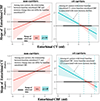Interaction of APOE, cerebral blood flow, and cortical thickness in the entorhinal cortex predicts memory decline
- PMID: 32048144
- PMCID: PMC7165062
- DOI: 10.1007/s11682-019-00245-x
Interaction of APOE, cerebral blood flow, and cortical thickness in the entorhinal cortex predicts memory decline
Abstract
The ε4 allele of the apolipoprotein E (APOE) gene, a risk factor for cognitive decline, is associated with alterations in medial temporal lobe (MTL) structure and function, yet little research has been dedicated to understanding how these alterations might interact to negatively impact cognition. To bridge this gap, the present study employed linear regression models to determine the extent to which APOE genotype (ε4+, ε4-) modifies interactive effects of baseline arterial spin labeling MRI-measured cerebral blood flow (CBF) and FreeSurfer-derived cortical thickness/volume (CT/Vo) in two MTL regions of interest (entorhinal cortex, hippocampus) on memory change in 98 older adults who were cognitively normal at baseline. Baseline entorhinal CBF was positively associated with memory change, but only among ε4 carriers with lower entorhinal CT. Similarly, baseline entorhinal CT was positively associated with memory change, but only among ε4 carriers with lower entorhinal CBF. Findings suggest that APOE ε4 carriers may experience concomitant alterations in neurovascular function and morphology in the MTL that interact to negatively affect cognition prior to the onset of overt clinical symptoms. Results also suggest the presence of distinct multimodal neural signatures in the entorhinal cortex that may signal relative risk for cognitive decline among this group, perhaps reflecting different stages of cerebrovascular compensation (early effective vs. later ineffective).
Keywords: APOE ε4; Aging; Cerebral blood flow; Cognitive decline; Cortical thickness.
Figures




Similar articles
-
APOE modifies the interaction of entorhinal cerebral blood flow and cortical thickness on memory function in cognitively normal older adults.Neuroimage. 2019 Nov 15;202:116162. doi: 10.1016/j.neuroimage.2019.116162. Epub 2019 Sep 4. Neuroimage. 2019. PMID: 31493534 Free PMC article.
-
Assessment of Alzheimer's disease risk with functional magnetic resonance imaging: an arterial spin labeling study.J Alzheimers Dis. 2012;31 Suppl 3(0):S59-74. doi: 10.3233/JAD-2012-120292. J Alzheimers Dis. 2012. PMID: 22531427 Free PMC article.
-
Differential effects of the APOE genotype on brain function across the lifespan.Neuroimage. 2011 Jan 1;54(1):602-10. doi: 10.1016/j.neuroimage.2010.08.009. Epub 2010 Aug 10. Neuroimage. 2011. PMID: 20705142
-
Design considerations for characterizing psychiatric trajectories across the lifespan: application to effects of APOE-ε4 on cerebral cortical thickness in Alzheimer's disease.Am J Psychiatry. 2011 Sep;168(9):894-903. doi: 10.1176/appi.ajp.2011.10111690. Epub 2011 Jul 1. Am J Psychiatry. 2011. PMID: 21724665 Free PMC article. Review.
-
Modulation of Human Memory by Deep Brain Stimulation of the Entorhinal-Hippocampal Circuitry.Neuron. 2020 Apr 22;106(2):218-235. doi: 10.1016/j.neuron.2020.02.024. Neuron. 2020. PMID: 32325058 Free PMC article. Review.
Cited by
-
Cerebral hypoperfusion, brain structural integrity, and cognitive impairment in older APOE4 carriers.Geroscience. 2025 Jun;47(3):4973-4986. doi: 10.1007/s11357-025-01642-5. Epub 2025 Apr 12. Geroscience. 2025. PMID: 40220152 Free PMC article.
-
Recollection-related fMRI effects in entorhinal cortex predict longitudinal memory change in healthy older adults.Neurobiol Aging. 2025 Mar;147:150-162. doi: 10.1016/j.neurobiolaging.2024.12.011. Epub 2024 Dec 27. Neurobiol Aging. 2025. PMID: 39765133
-
Aerobic exercise improves hippocampal blood flow for hypertensive Apolipoprotein E4 carriers.J Cereb Blood Flow Metab. 2021 Aug;41(8):2026-2037. doi: 10.1177/0271678X21990342. Epub 2021 Jan 28. J Cereb Blood Flow Metab. 2021. PMID: 33509035 Free PMC article.
-
Lower neurovascular coupling response despite higher cerebral blood flow at rest in apolipoprotein ɛ4 positive adults.PLoS One. 2024 Dec 3;19(12):e0314744. doi: 10.1371/journal.pone.0314744. eCollection 2024. PLoS One. 2024. PMID: 39625920 Free PMC article.
-
Differential associations between apolipoprotein E alleles and cerebral myelin content in normative aging.Neuroimage. 2022 May 1;251:118988. doi: 10.1016/j.neuroimage.2022.118988. Epub 2022 Feb 9. Neuroimage. 2022. PMID: 35150834 Free PMC article.
References
-
- Alsop DC, Detre JA, Golay X, Günther M, Hendrikse J, Hernandez- Garcia L, … Zaharchuk G (2015). Recommended implementation of arterial spin-labeled perfusion MRI for clinical applications: A consensus of the ISMRM perfusion study group and the European consortium for ASL in dementia. Magnetic Resonance in Medicine, 73(1), 102–116. 10.1002/mrm.25197 - DOI - PMC - PubMed
-
- Asllani I, Habeck C, Scarmeas N, Borogovac A, Brown TR, & Stern Y (2008). Multivariate and univariate analysis of continuous arterial spin labeling perfusion MRI in Alzheimer’s disease. Journal of Cerebral Blood Flow and Metabolism: Official Journal of the International Society of Cerebral Blood Flow and Metabolism, 28(4), 725–736. 10.1038/sj.jcbfm.9600570 - DOI - PMC - PubMed
-
- Bangen KJ, Restom K, Liu TT, Jak AJ, Wierenga CE, Salmon DP, & Bondi MW (2009). Differential age effects on cerebral blood flow and BOLD response to encoding: Associations with cognition and stroke risk. Neurobiology of Aging, 30(8), 1276–1287. 10.1016/j.neurobiolaging.2007.11.012 - DOI - PMC - PubMed
MeSH terms
Substances
Grants and funding
LinkOut - more resources
Full Text Sources
Medical
Miscellaneous

